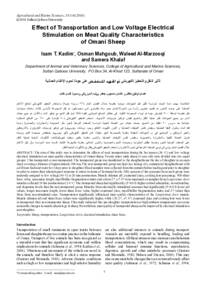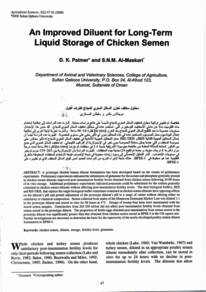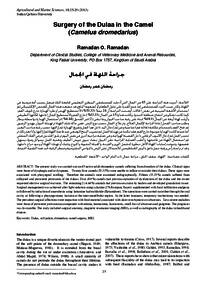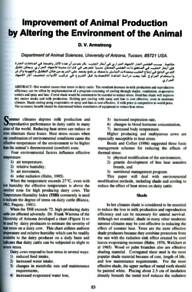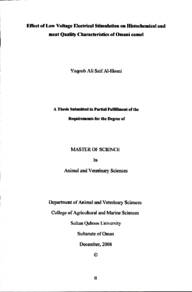Document
Composition, Quality and Health Aspects of the Dromedary (Camelus dromedarius) and Bactrian (Camelus bacterianus) Camel Meats: A Review.
Contributors
Mahgoub, Osman., Author
Al-Marzooqi, Waleed., Author
Khalaf, Samera K., Author
Raiymbek, Gulzhan., Author
Publisher
جامعة السلطان قابوس. كلية العلوم الزراعية والبحرية
Gregorian
2013
Language
English
English abstract
The dromedary and bactrian camels are good sources of high quality protein especially in areas where the climate adversely affects the survival of other livestock. The camel has unique physiological characteristics, including a great tolerance to high and low temperatures, solar radiation, water scarcity, rough topography and poor vegetation. Camels are mostly produced under traditional systems on poor levels of nutrition and are mostly slaughtered at old ages after completing a career in work, racing or milk production. In general, camel carcasses contain about 57% muscle, 26% bone and 17% fat with fore-quarters (cranial to rib 13) significantly heavier than the hind halves. Camel lean meat contains about 78% water, 19% protein, 3% fat, and 1.2% ash with a small amount of intramuscular fat, which renders it a healthy food for growing human populations. The amino acid and mineral contents of camel meat are often higher than other meat animals, probably due to lower intramuscular fat levels. Camel meat has been processed into burgers, patties, sausages and shawarma to add value. Future research efforts need to focus on exploiting the potential of the camel as a source of meat through multidisciplinary research into efficient production systems and improved meat technology and marketing.
Member of
ISSN
2410-1079
Resource URL
Arabic abstract
تعتبر الإبل ذات السنام الواحد أو السنامين من المصادر الجيدة للبروتين ذو القيمة الغذائية العالية وخاصة في المناطق ذات الطبيعة البيئية القاسية والتي تؤثر سلبيا على بقاء حيوانات المزرعة الأخرى. تتميز الإبل بصفات وظيفية فريدة والتي تتضمن تحملها لدرجات الحرارة العالية أو المنخفضة وأشعة الشمس المباشرة وقلة توفر المياه والطبوغرافيا القاسية للمناطق التي تعيش فيها وقلة الغطاء النباتي. تربى الإبل بطرق تقليدية مع عدم توفر متطلباتها الغذائية وتذبح عند أعمار كبيرة بعد انتهاء العمر الإنتاجي للحيوان من إنتاج الحليب أو التي لم تعد صالحة للسباق. تحتوي ذبائح الإبل بصورة عامة على 57% من العضلات و 26% من العظام و 17% من الدهون مع ثقل الربع الأمامي مقارنة بالربع الخلفي للذبيحة. تتكون لحوم الإبل من 78% من الماء و 19% من البروتين و 3% من الدهن و 1.2% من الأملاح وتعتبر قلة الدهون العضلية للحوم الإبل من المواد الغذائية الصحية في تغذية العدد المتزايد من البشر. يعتبر محتوى لحوم الإبل من الأحماض الأمينية والأملاح المعدنية أعلى من مثيلاتها من لحوم بقية الحيوانات بسبب انخفاض نسبة الدهون في عضلاتها. يمكن صنع الهمبيرجر والنقانق والشاورما من لحوم الإبل لزيادة قيمتها الغذائية. لذلك يجب أن تتركز البحوث المستقبلية على تحسين طرق التربية لزيادة إنتاج اللحوم مع الاهتمام بتحسين تقنية تصنيع لحوم الإبل ولتسويق اللحوم ومنتجاتها.
Category
Journal articles


